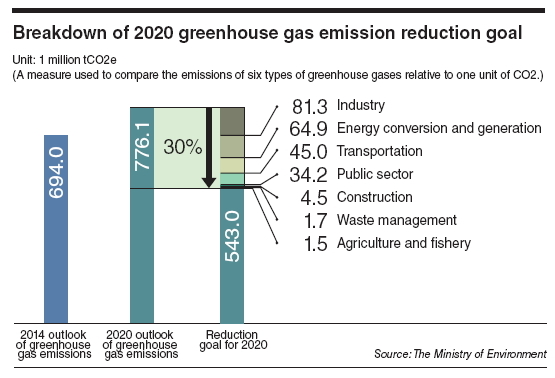This year, Korea plans to cut greenhouse gas emissions by 5.1 percent to 65.9 billion tCO2e.
 |
|
Source: The Ministry of Environment |
The Korean government aims to cut the country’s greenhouse gas emissions by 30 percent from projected levels by 2020 to hold back global warming, the Ministry of Environment said Tuesday.
The plan is aimed at reducing 233 million carbon dioxide equivalent tons by 2020, a 30 percent cut from the expected 2020 BAU level of 776 million tCO2e, according to the ministry officials.
The target was originally set in 2011 by the former administration of President Lee Myung-bak. The officials said the new blueprint features more detailed reduction policies and measures for seven different sectors.
Target reduction rates are 18.5 percent for industry; 26.7 percent for energy conversion and generation; 26.9 for the building sector; 34.3 percent for transportation; and 25 percent for the public sector.
The rates for the waste management and agriculture and fishery sectors were set at 12.3 percent and 5.2 percent, respectively.
This year, the environment authorities plan to cut greenhouse gas emissions by 5.1 percent to 65.9 billion tCO2e, from the expected 69.4 billion tCO2e.
The ministry expected the plan to help generate about 3,000 environment-related jobs through 2020.
Korea, the ninth-highest producer of carbon emissions, has been reviewing the previous version of the greenhouse gas reduction plan due to a hike in gas emissions in 2010. The increase was the largest in 17 years.
Along with the road map, the government will separately launch the so-called cap-and-trade scheme that allows local firms to buy or sell greenhouse emission rights on the Korea Exchange’s trading platform.
The government will allot free permits until 2017 to companies or factories which have annual gas emissions averaging 125,000 and 25,000 tCO2e, respectively.
Any businesses that exceed the emission cap will be fined, while those emitting less will be able to carry the difference through to the next month.
By Suk Gee-hyun (monicasuk@heraldcorp.com)